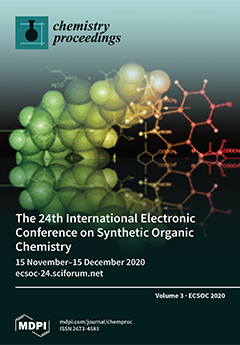Benzimidazole derivatives represent a class of heterocyclic compounds that exhibit a wide range of pharmaceutical properties. The present study aimed to investigate the in-vitro antioxidant and antimicrobial activities of newly synthesized benzimidazole derivatives. Compound
1b (2-(1H-1,3-benzodiazol-2-yl) phenol) was synthesized by reacting o-phenylenediamine (OPA)
[...] Read more.
Benzimidazole derivatives represent a class of heterocyclic compounds that exhibit a wide range of pharmaceutical properties. The present study aimed to investigate the in-vitro antioxidant and antimicrobial activities of newly synthesized benzimidazole derivatives. Compound
1b (2-(1H-1,3-benzodiazol-2-yl) phenol) was synthesized by reacting o-phenylenediamine (OPA) with chemical salicylaldehyde, while compounds
2b (2-(2-[(1E)-2-phenylethenyl]-1H-1,3-benzodiazole) and
3b (2-[(1E)-2,6-dimethylhepta-1,5-dien-1-yl]-1H-1,3-benzodiazole) were obtained through a hemi-synthesis process of, respectively, the cinnamon (cinnamaldehyde, 90.54%) and lemongrass (cis-citral, 43.9%) essential oils previously characterized by GC/MS. Compounds
4b (2-phenyl-1H-benzimidazole) and
5b (5-(1H-benzimidazol-2-yl)benzene-1,2,3-triol) were synthesized with a click chemistry method by reacting the OPA with benzoic acid and gallic acid directly in ethanol under microwave irradiation (MW) at 400 MHz. The structure/purity of the synthesized compounds was clarified by spectroscopy, ATR-FTIR and NMR
1H. Compounds
1b–
5b were screened for their antioxidant activity by using four complementary in-vitro assays: DPPH scavenging activity, ferric ion reducing power, β-carotene bleaching inhibition, and Thiobarbituric Acid Reactive Substance Assay (TBARS) formation inhibition. All the tested compounds showed antioxidant potential, with varying performance. Antimicrobial activity was investigated against American Type Culture Collection (ATCC) strains (three Gram- bacteria:
Escherichia coli,
Salmonella typhi, and
Pseudomonas aeruginosa; one Gram+ bacteria:
Staphylococcus aureus, and one yeast strain:
Candida albicans) through the determination of the Minimum Inhibitory Concentration (MIC) and the Minimum Bactericidal Concentration (MBC) by using the microdilution method and rapid colorimetric test of p-iodonitrotetrazolium chloride (INT). Compound
5b exhibited the highest potential, especially against
S. aureus (MIC = 0.156 mg·mL
−1) followed by
S. typhi and
C. albicans (MIC = 0.3125 mg·mL
−1) and then by
E. coli and
P. aeruginosa. Compound
1b also showed great potential against
S. aureus and
C. albicans (MIC ˂ 0.3125 mg·mL
−1), followed by
E. coli and
S. typhi (MIC = 0.3125 mg·mL
−1) and
P. aeruginosa (MIC = 0.625 mg·mL
−1). Further molecular docking was conducted using AutoDock Vina 1.1.2 software on
S. aureus thymidylate kinase (TMK) protein to highlight the structure–activity relationship of the potent molecules.
Full article



